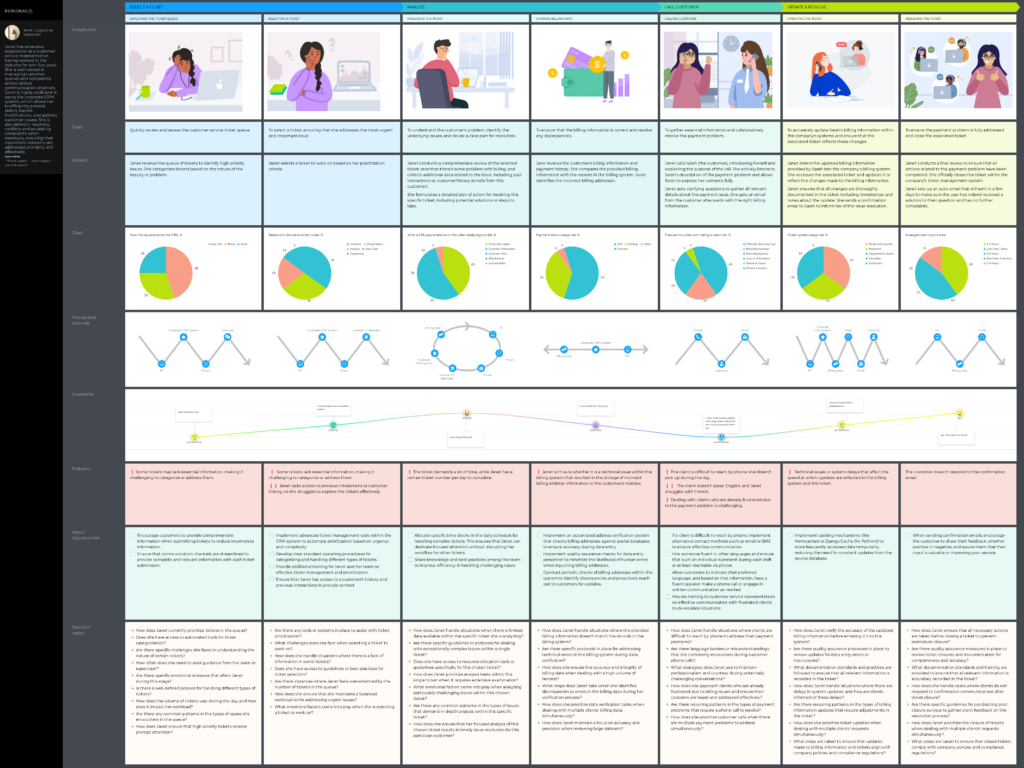You’re a business on a journey, and your destination is exceptional customer service. The compass on this voyage? The customer service representative (CSR) who helps customers stay on the right course. But if your CSR's experience has its share of issues, the ship can run aground.
To eliminate this scenario, it's essential to tackle these issues head-on; otherwise, they will they will keep on accumulating. The solution may entail closely analyzing the customer service representative experience and their journey, pinpointing and resolving issues at different stages. If you're prepared to take action, you've come to the right place.
Contents
Where do we start? With research
Research matters when it comes to any experience initiative. It provides valuable insights and a data-driven understanding of customer interactions.
Why research is crucial
- It helps determine specific areas where CSRs encounter difficulties or frustration during interactions with customers or colleagues. Addressing these pain points can also improve employee experience and customer satisfaction.
- Through research, businesses can identify inefficient processes or bottlenecks in the customer service representative journey. This enables streamlining and optimizing workflows, resulting in more efficient service delivery.
- Research data aids in the development of targeted training programs for CSRs. It helps understand where additional training or support may be required to enhance the critical customer service skills and knowledge of customer service teams.
- Research provides benchmark data that allows businesses to measure CSR performance accurately. It helps in setting clear performance goals and tracking progress toward achieving them.

But how do you obtain relevant and accurate information regarding an in-house employee's journey?
Where to look for research data?
Some of the proven tactics include:
- Review existing customer service data, like customer feedback, complaints, and call logs.
- Analyze performance metrics such as response times, issue resolution rates, and customer satisfaction scores.
- Conduct surveys and interviews with your CSRs to gather firsthand insights. Ask about a day in the life of a customer service representative: their tasks, challenges, and interactions with customers. Discover their pain points, successes, and suggestions for improvement.
- Spend time observing CSRs in action. Shadowing lets you see their interactions with customers and how they handle various scenarios. Take notes on their processes, communication style, and everything that will capture your attention.
- Collect direct feedback from customers who have interacted with CSRs. Use surveys, feedback forms, or post-interaction surveys to gather insights into their experiences. Pay attention to both positive and negative feedback.
- Utilize customer relationship management and ticketing systems to access data on customer interactions. Look at the history of customer questions, resolutions, and communication logs.
- Study how competitors provide good customer service and gather insights on industry best practices.
- Refer to industry reports, case studies, and surveys related to customer service. These sources can provide valuable benchmarks and insights into industry standards.
- Establish feedback loops within your organization where CSRs can provide input on process improvements. Encourage regular communication and idea sharing among them.
By combining insights from these sources, you can create a comprehensive view of the CSR journey. But first and foremost, this information will help you build your customer service representative persona.
Creating a customer service representative persona
To begin with, it's essential to segment the audience using the gathered data. Once you've figured out the principles for defining your personas, it's the perfect time to move on to creating their profiles.
What to inclide in a profile? Think it through logically: do you require demographics for the project's objectives, or would it be better to concentrate on behavioral patterns?
Another crucial aspect is what informational sections to include in your persona profile to make it informative and empathy-inducing.
You might be wondering, "Why is empathy relevant here?" The key is that those engaged in a journey mapping initiative should not treat it as a cold, heartless project; otherwise, it won't yield fruitful outcomes. It's vital to truly empathize with the persona whose experience you intend to enhance. To do this, their profile shouldn't be merely a block of text or a collection of figures; it should be a portrayal of a person, albeit a composite one, but a real one at heart.
Common persona profile sections
There can be different sections in a persona. Some of the common ones include:
- Photo and name. Yes, they should be fictional but relatable. It's unlikely that an employee named "Mars Venus" with George Clooney's face will be convincing enough to evoke empathy towards the persona and make their journey feel real.
- Average demographics. This is at your discretion. For example, the number of years of experience often correlates with a CSR's level of expertise and competence in handling customer inquiries. More experienced CSRs may have encountered a wider range of customer complaints and developed effective strategies for resolution. They will not be nervous even when handling the most challenging cases.
- Background. You need to understand what shapes your persona's character. Some might argue that information about having two old dogs is irrelevant, but we know that for dog owners, it's likely to be essential to get home on time to walk their pets. Therefore, work delays could be a source of stress and may affect customers' interactions.
- Quote. It would be great if you could extract a memorable quote from your interactions with actual employees that reflects your persona's character and add it to a dedicated section.
- Motivations and frustrations. Knowing what drives your persona (e.g., recognition and positive feedback) and what hinders them from performing at their best (e.g., an overwhelming number of customer inquiries) will help you improve their journey within the company.
- Skills. Your persona may have some special customer service competence (e.g., multilingual customer support) or gaps in basic skills (e.g., active listening or product knowledge); reflect this in their profile.
- Technical details. What technology does your persona use? It provides valuable context for understanding their experience, optimizing their workflow, and ensuring they have the necessary tools and support to perform their role effectively.
- Communication channels. Many personas use multiple communication channels in their daily tasks. Understanding how they switch between channels and the reasons for doing so provides insights into their experience.
- Personality traits. We bring ourselves everywhere, including to work. Therefore, key characteristics of your CSR's personality also matter. They can have a strong sense of empathy, connect with customers on a deeper level, anticipate customer needs, take the initiative to address issues before they escalate, and approach challenges with assurance.
The types and number of persona profile sections may vary. The key is creating a real person-like character that makes sense in your case.
As an example, we have a persona based on the points mentioned above. Let's call her Janet, an employee in the customer service department:
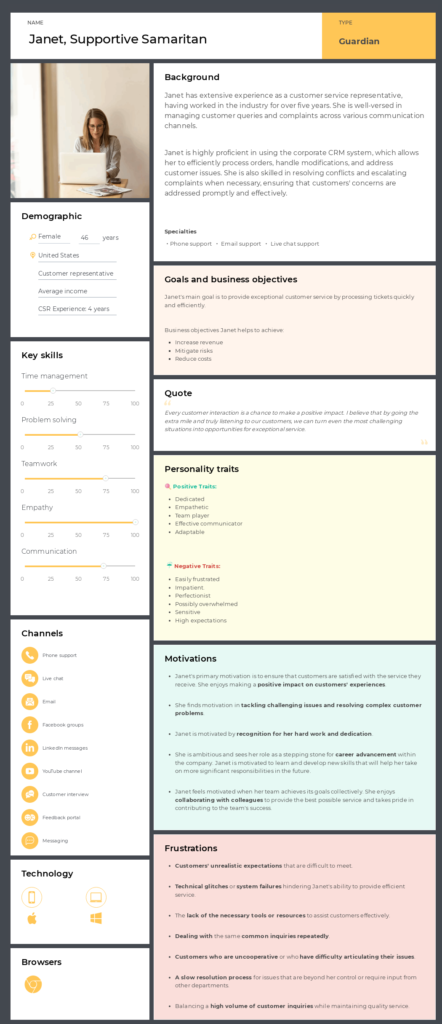
Wanna take a closer look at this persona? Click here.
Now that we have our persona, it's the perfect time to delve into their journey.
Mapping a customer service representative experience
Journey maps can take different forms, and we like a table-like one, where…
- the horizontal axis represents journey stages;
- and the vertical axis represents the information we will depict for each stage.
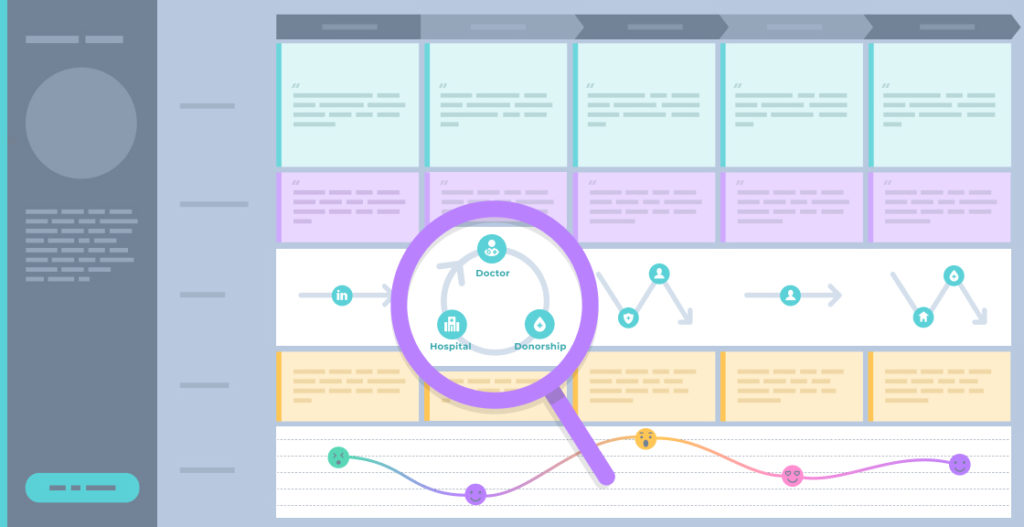
In terms of stages, it all depends on the journey scope that is important for your project. For example, you can aim for an end-to-end customer service representative journey. In that case, you are likely to cover:
- Navigating the first steps (initial training and orientation for new customer service representatives);
- Daily duties (the typical daily tasks and responsibilities of a customer support representative, moments of interaction with customers);
- Issue resolution (identifying and resolving customer issues);
- Team support (interaction with colleagues and supervisors for support and guidance);
- Customer voices (gathering feedback from customers regarding issue resolution);
- Professional development in the company (training programs and resources for personal growth).
Let's take a moment to focus on the vertical aspect of our map, the information that you can cover for each stage:
- Persona’s goals. What your persona is trying to achieve at a specific stage.
For the Customer Inquiry Resolution stage, your persona’s goal can be to efficiently resolve customer inquiries while ensuring high customer satisfaction.
- Persona’s actions. List the specific steps or actions the CSR persona takes during the stage, including their tasks and responsibilities.
The persona reviews incoming customer inquiries in the queue.
- Channels. Outline the interaction channels used by the CSR persona to communicate with customers and colleagues during the stage.
The CSR reaches out to a customer via phone, taking notes in the in-house CRM.
- Emotions. Capture the emotional state of the persona, noting how they feel at different points within the stage.
Your persona’s mood brightens when she successfully resolves a customer's issue, experiencing a sense of accomplishment.
- Quotes. Include direct quotes from the customer service representative persona to provide authentic insights into their thoughts and reactions.
"Hello, this is Sarah from Customer Support. I'm here to help. How can I make your day better?"
- Storyboards. Create visual representations or narratives illustrating key moments and interactions within the stage.

- Touchpoints. All the touchpoints that occur between the CSR persona and customers or colleagues, both digital and physical.
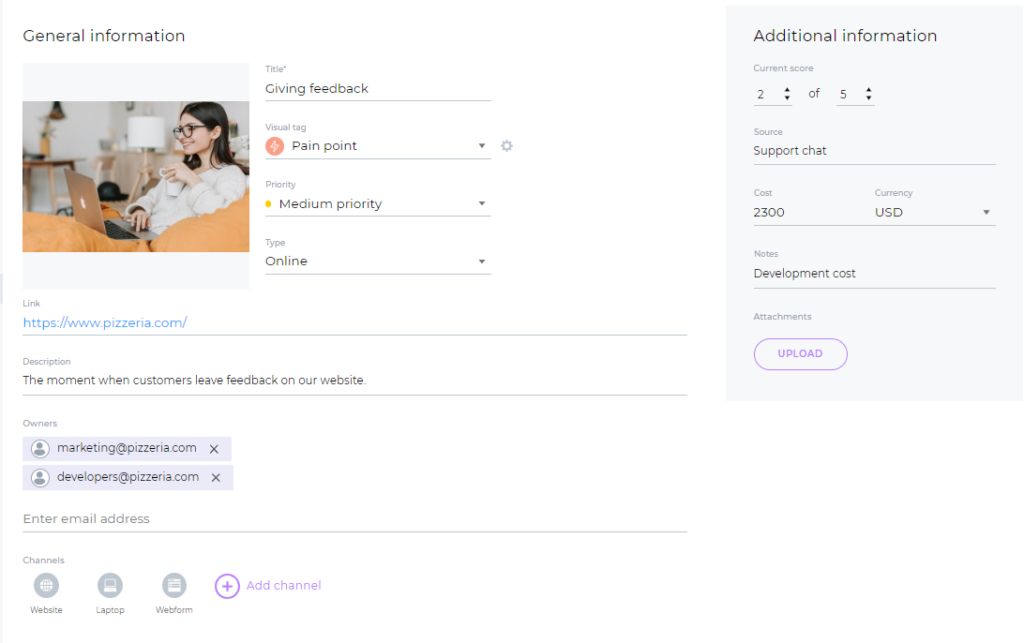
- KPIs. Identify the relevant business/marketing/any other KPIs related to a stage. They may include:
- First-Contact Resolution Rate (FCR). The percentage of customer complaints or issues that are resolved during the initial contact with the CSR without requiring further follow-ups.
- Net Promoter Score (NPS). A metric that assesses customer loyalty and willingness to recommend the company's products or services based on their interaction with the CSR.
- Problems. Highlight any issues or obstacles encountered by the customer service representative persona.
- Ideas and areas of improvements. These are potential improvements or innovative ideas that could enhance the CSR's journey.
Together, these components give a complete look at the customer service employee persona's journey and provide helpful insights for improving it. Read on to learn more about the stages, typical problems, and ideas on how to overcome them. We’re going to use the general stages mentioned above as examples.

As customer service staff embark on their journey in your company, several key aspects demand attention. They actively participate in training programs to familiarize themselves with company policies, products, and customer service protocols.
Potential challenges and ways to fix those:
- New customer service representatives may struggle with an abundance of information.
Solution: Break down the training content into smaller, digestible modules. Provide comprehensive but focused sessions over a longer period to prevent overwhelming new CSRs.
- If training is too monotonous, engagement can drop quickly.
Solution: Introduce interactive elements into training, such as quizzes, discussions, and group activities. Incorporate real-life scenarios and case studies to make the training more engaging and relatable.
- customer service representatives might feel lost without a clear understanding of their role in the company.
Solution: Develop and distribute role-specific documents or guides that outline CSR responsibilities clearly. Conduct regular one-on-one or group meetings to discuss roles and expectations. Encourage open communication for role clarification.
- Difficulty accessing training materials can hinder progress.
Solution: Ensure that all training materials are easily accessible through a user-friendly online platform or document repository. Provide technical support for any access issues. Offer alternative access methods, such as printed materials or offline resources, for those with limited technology access.
Daily duties

Customer service professionals engage in critical interactions with customers, shaping the overall customer experience. This stage represents the frontline, where CSRs directly address inquiries, resolve issues, and build rapport with customers. While this stage represents the routine, it's essential to consider potential challenges and solutions to ensure the ongoing success of CSRs.
Potential challenges and ways to fix those:
- Customer service representatives may face periods of high call volumes or numerous inquiries, which can lead to feeling overwhelmed.
Solution: Implement efficient workload distribution strategies. Offer regular breaks and stress management resources to help a customer service professional cope during peak times.
- Dealing with angry or dissatisfied customers can be emotionally taxing.
Solution: Provide advanced customer service training to equip CSRs with conflict resolution skills. Encourage a supportive team environment where they can share experiences and solutions.
- Interactions with diverse customers may involve language or cultural differences that can impact communication efficiency.
Solution: Provide cultural sensitivity and diversity training to your staff. Offer multilingual support or translation services to bridge language gaps.
- Ensuring a consistent and positive tone at every customer interaction.
Solution: Establish clear communication guidelines and standards. Conduct periodic quality assurance checks and provide feedback to customer service representatives to maintain consistency.
- Keeping up with product updates, policy changes, and new information.
Solution: Implement a robust knowledge management system with easy access to up-to-date information. Schedule regular training sessions or internal demos to keep customer service employees informed.
- Prioritizing and managing tasks effectively.
Solution: Provide time management training to help CSRs organize their duties efficiently. It can be something within your company or outside courses. Implement task prioritization tools or systems to assist in managing responsibilities.
Issue resolution

This is when CSRs are tasked with identifying and resolving customer issues. This process directly impacts customer satisfaction and loyalty.
By the way, we already built a customer service representative journey map template dedicated to this very stage. It features our sample persona, Janet, who interacts with tickets in the company's CRM system and resolves a particular user's issue. Here are the stages we covered:
- Selecting a ticket, which we divide into substages (more narrow-focus parts of a stage with separate goals and actions): Exploring the ticket queue and Selecting a ticket;
- Analyzing, which we also divide into substages; those are Analyzing the ticket and Opening billing info;
- Calling the customer;
- Updating & resolving, again, split into two substages: Updating the ticket and Resolving it.
And here is our map:
Potential challenges during the Issue resolution and ways to fix those:
- CSRs may encounter challenges in accurately identifying and understanding the complexities of some customer issues.
Solution: Offer specialized training in issue categorization and root cause analysis. Implement advanced case management tools (e.g., Zendesk or Kayako) to assist in identifying complex issues.
- There may be instances where issues require escalation to higher levels of support, which can cause delays.
Solution: Develop transparent and efficient escalation procedures. Provide guidelines on when and how to escalate issues to ensure timely resolution.
- Meeting customer expectations, especially when issues take time to resolve and should be treated with great delicacy.
Solution: Equip CSRs with effective communication techniques to help set realistic expectations without overpromising. Implement proactive communication with customers during longer resolution processes.
- Technical issues or system glitches may hinder the resolution process.
Solution: Ensure customer service employees can access technical support teams or resources for swift technical issue resolution. Implement regular system maintenance and updates to reduce disruptions.
Team support

At this stage, CSRs engage with their colleagues and supervisors to seek support, guidance, and a sense of belonging. It represents a critical aspect of their role, ensuring they can effectively navigate complex customer inquiries and challenges.
Potential challenges and ways to fix those:
- Effective communication with colleagues and supervisors is essential, but there’s always room for miscommunication.
Solution: Provide communication training focused on active listening and expressing thoughts. Include regular meetings in the department's planning.
- Sharing knowledge and best practices among customer service team members can be challenging, especially when dealing with diverse issues.
Solution: Create a knowledge-sharing platform or database where everyone on the team can contribute and access valuable insights and solutions. Encourage cross-training to broaden knowledge.
- Conflicts or disagreements among team members can disrupt workflow and morale.
Solution: Offer conflict resolution training to equip CSRs with conflict management skills. Set up a structured process for addressing and resolving conflicts professionally.
- Availability and accessibility of supervisors for guidance may vary, impacting CSRs' ability to seek support.
Solution: Implement a schedule for supervisor availability or designate team leads who can guide in supervisors' absence.
Customer voices
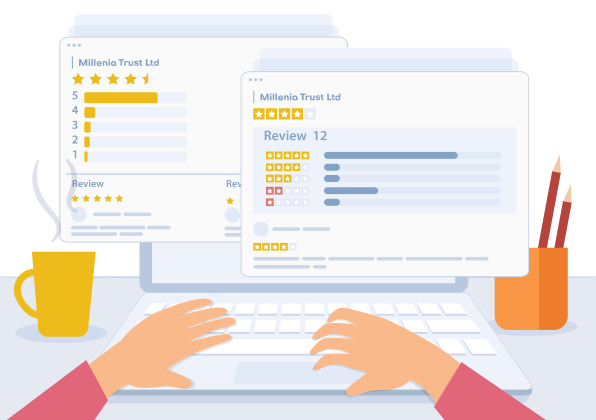
At this stage, CSRs seek customer feedback regarding resolving their issues. Gathering customer voices is crucial for understanding the quality of service provided, identifying areas for improvement, and maintaining strong customer relationships.
Potential challenges and ways to fix those:
- Customers may be hesitant to provide feedback or may not feel inclined to do so.
Solution: Create user-friendly feedback channels, such as online surveys or post-interaction email prompts, to encourage customers to share their thoughts. Offer incentives for feedback participation.
- Dealing with negative or critical feedback can be emotionally challenging for a customer service representative.
Solution: Provide training in handling negative feedback professionally and constructively. Implement an approach for customer service representative duties and responsibilities to discuss and share strategies for addressing critical comments.
- Managing a high volume of feedback responses can be overwhelming and time-consuming.
Solution: Utilize feedback management tools to automate data collection and categorization. Implement a structured process for reviewing and responding to feedback.
- Some feedback may lack specificity or detail, making it challenging to address.
Solution: Develop feedback collection forms that prompt customers for specific information and context. Encourage CSRs to follow up with customers to gather additional details when necessary.
Professional development

During this stage, CSRs engage in professional development activities to enhance their skills, knowledge, and personal growth. It is a vital aspect of their journey, ensuring they are well-equipped to meet evolving customer service demands and career aspirations.
Potential challenges and ways to fix those:
- Balancing daily duties with professional development activities can be challenging.
Solution: Create a flexible schedule that allows your employees to allocate dedicated time for training and development while maintaining a good quality of their work.
Wrapping up
In the world of customer service, the customer service representative experience is the linchpin that holds the journey together. As we've explored in this article, the path to exceptional customer service is filled with challenges and opportunities. From research and persona creation to mapping the CSR's journey, we've uncovered valuable insights and solutions.
Now you can do that yourself. Just remember that exceptional customer service is not a destination; it's an ongoing voyage. And with a dedicated focus on enhancing the CSR's experience, businesses can chart a course towards excellence, ensuring happy employees, satisfied customers, and lasting success.
